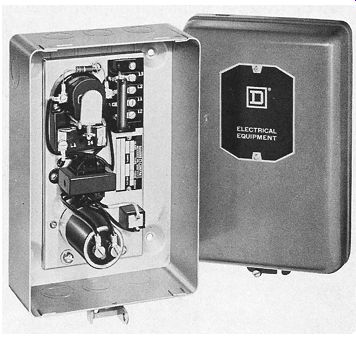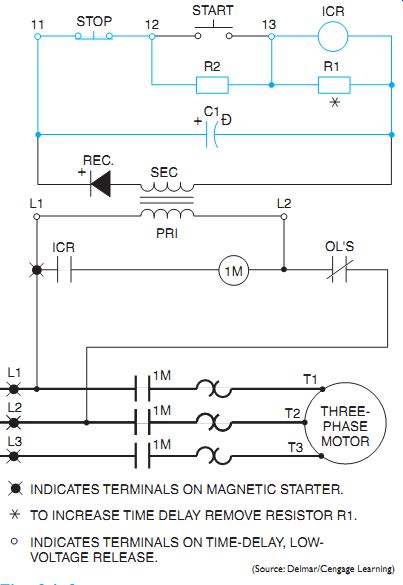AMAZON multi-meters discounts AMAZON oscilloscope discounts
Goals:
• Describe the purpose of a time-delay, low-voltage release relay.
• Describe the construction and operation of a time- delay, low-voltage release relay.
• Make proper connections to insert this type of relay in a circuit that contains a motor starter and a push-button station.
• Read and interpret control diagrams of low-voltage release relay.
There is a possibility of injury to an operator or damage to machinery when the power suddenly resumes after a prolonged voltage failure. Therefore, it's desirable to provide some means of preventing motors from restarting in such cases. One method of preventing motor restart is known as low-voltage protection or three wire control. However, three-wire control isn't practical because momentary line voltage fluctuations occur in many localities, or the voltage actually fails for only a few seconds. Remember that with three-wire control, each time a volt age failure occurs the motors must be restarted manually. This is a time-consuming procedure and , in some instances, can cause damage to material in process or production.

Ill. 1 Time-delay, low-voltage release relay.
One solution to this problem is to use a time delay, low-voltage release device, ill. 1.
When this device is used with a magnetic starter and a momentary contact push-button station, the motor is automatically reconnected to the power lines after a voltage failure of short duration. If the voltage failure exceeds the time delay setting of the low-voltage release device, or if the stop button is pressed, the motor won't restart automatically; it must be restarted by pressing the start button. As a result, the use of a time-delay, low-voltage release device provides the safety of three-wire control. In addition, it eliminates the inconvenience of a loss of production time where momentary voltage failures are common.

ill. 2 Elementary diagram of low-voltage release: INDICATES TERMINALS ON MAGNETIC
STARTER. TO INCREASE TIME DELAY REMOVE RESISTOR R1. INDICATES TERMINALS ON
TIME-DELAY, LOW-VOLTAGE RELEASE.
CONSTRUCTION AND OPERATION
The time-delay, low-voltage release device consists of a single-pole, normally open control relay, an electrolytic capacitor, a rectifier, two resistors, and a control transformer, ill. 2. Resistor R1 is connected in parallel with the coil of the control relay CR1 to provide a time delay of approximately 2 seconds. Removal of this resistor provides a time delay of approximately 4 seconds.
When used with a magnetic starter and a momentary contact, start-stop push-button station, the coil of the low-voltage release relay is connected to the secondary of the transformer through the rectifier and a resistor. Current flows through the relay coil at all times. The value of resistor R2, however, is such that the current flowing through the coil is too low to allow relay pickup.
When the start button is pressed, resistor R2 is cut out, full voltage is applied to the relay coil, and the relay is energized. (When the start button is released, the resistor is again in series with the relay coil. The relay, however, is still energized because less current is required to hold the relay once it's picked up.) A relay contact 1CR is wired in series with the operating coil 1M of the magnetic starter. This contact closes and allows the operation of the magnetic starter.
If the line voltage is reduced or fails completely, the electrolytic capacitor C1, which is charged through the rectifier, discharges through the control relay coil to keep the coil energized. The time required for the capacitor to discharge is a function of the resistance in the circuit and the capacitance of the device.
If the line voltage returns to approximately 85 percent of its normal value before the capacitor is discharged, the magnetic starter automatically recloses and restarts the motor. If the voltage does not return to normal before the capacitor is discharged, the control relay opens.
As a result, to restart the motor the push button must be pressed when power is returned.
At any time, pushing the stop button causes the control relay to be de-energized. The starter circuit then opens immediately.
QUIZ:
1. In the event of line voltage fluctuations or failure, how is the starter maintained in a closed position?
2. How is this principle applied to a DC starter?
3. Under what condition will the motor restart automatically after a voltage failure?
4. Explain in detail the purpose of a time-delay, low-voltage release relay assembly installed in a motor control circuit.